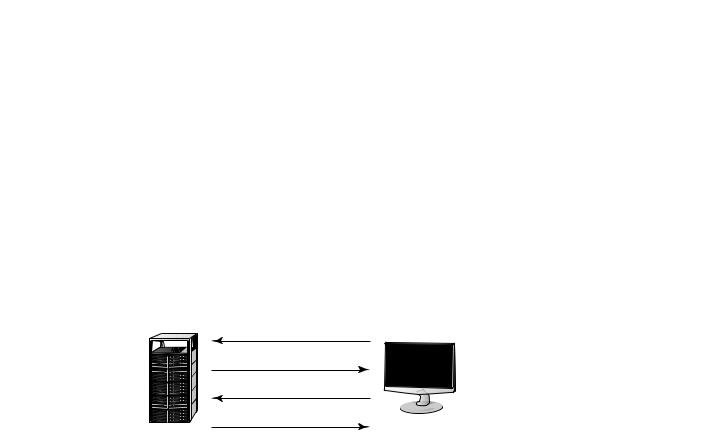
CISSP - Certified Information Systems Security Professional Study Guide, 2nd Edition (2004)
.pdf
Answers to Review Questions |
251 |
15.D. The maximum allowed ping packet size is 65,536 bytes. To engage in a ping of death attack, an attacker must send a packet that exceeds this maximum. Therefore, the smallest packet that might result in a successful attack would be 65,537 bytes.
16.D. Hostile applets are a type of malicious code that users download from a remote website and run within their browsers. These applets, written using technologies like ActiveX and Java, may then perform a variety of malicious actions.
17.B. Alan has implemented pseudo-flaws in his production systems. Honey pots often use pseudoflaws, but they are not the technology used in this case because honey pots are stand-alone systems dedicated to detecting hackers rather than production systems.
18.D. The Java sandbox isolates applets and allows them to run within a protected environment, limiting the effect they may have on the rest of the system.
19.C. The Fraggle attack utilizes the uncommonly used UDP services chargen and echo to implement a denial of service attack.
20.B. The Land attack uses a TCP packet constructed with the SYN flag set and identical source and destination sockets. It causes older operating systems to behave in an unpredictable manner.

252 Chapter 8 Malicious Code and Application Attacks
Answers to Written Lab
Following are answers to the questions in this chapter’s written lab:
1.Viruses and worms both travel from system to system attempting to deliver their malicious payloads to as many machines as possible. However, viruses require some sort of human intervention, such as sharing a file, network resource, or e-mail message, to propagate.
Worms, on the other hand, seek out vulnerabilities and spread from system to system under their own power, thereby greatly magnifying their reproductive capability, especially in a well-connected network.
2.The Internet Worm used four propagation techniques. First, it exploited a bug in the sendmail utility that allowed the worm to spread itself by sending a specially crafted e-mail message that contained the worm’s code to the sendmail program on a remote system. Second, it used a dictionary-based password attack to attempt to gain access to remote systems by utilizing the username and password of a valid system user. Third, it exploited a buffer overflow vulnerability in the finger program to infect systems. Finally, it analyzed any existing trust relationships with other systems on the network and attempted to spread itself to those systems through the trusted path.
3.In a typical connection, the originating host sends a single packet with the SYN flag enabled, attempting to open one side of the communications channel. The destination host receives this packet and sends a reply with the ACK flag enabled (confirming that the first side of the channel is open) and the SYN flag enabled (attempting to open the reverse channel). Finally, the originating host transmits a packet with the ACK flag enabled, confirming that the reverse channel is open and the connection is established. In a SYN flood attack, hackers use special software that sends a large number of fake packets with the SYN flag set to the targeted system. The victim then reserves space in memory for the connection and attempts to send the standard SYN/ACK reply but never hears back from the originator. This process repeats hundreds or even thousands of times and the targeted computer eventually becomes overwhelmed and runs out of available memory for the half-opened connections.
4.If possible, it may try to disinfect the file, removing the virus’s malicious code. If that fails, it might either quarantine the file for manual review or automatically delete it to prevent further infection.
5.Data integrity assurance packages like Tripwire compute checksum values for each file stored on a protected system. If a file infector virus strikes the system, this would result in a change in the affected file’s checksum value and would, therefore, trigger a file integrity alert.

Chapter |
Cryptography and |
9 |
Private Key Algorithms |
|
|
THE CISSP EXAM TOPICS COVERED IN THIS |
|
|
CHAPTER INCLUDE: |
|
Use of Cryptography to Achieve Confidentiality, Integrity, |
|
Authentication, and Nonrepudiation |
|
Cryptographic Concepts, Methodologies, and Practices |
|
Private Key Algorithms |

Cryptography provides added levels of security to data during processing, storage, and communications. Over the years, mathematicians and computer scientists developed a series of increas-
ingly complex algorithms designed to ensure confidentiality, integrity, authentication, and nonrepudiation. During that same period, hackers and governments alike devoted significant resources to undermining those cryptographic algorithms. This led to an “arms race” in cryptography and resulted in the development of the extremely sophisticated algorithms in use today. This chapter takes a look at the history of cryptography, the basics of cryptographic communications, and the fundamental principles of private key cryptosystems. The next chapter continues the discussion of cryptography by examining public key cryptosystems and the various techniques attackers use to defeat cryptography.
History
Since the beginning of mankind, human beings devised various systems of written communication, ranging from ancient hieroglyphics written on cave walls to CD-ROMs stuffed with encyclopedias full of information in modern English. As long as mankind has been communicating, it has also used secretive means to hide the true meaning of those communications from the uninitiated. Ancient societies used a complex system of secret symbols to represent safe places to stay during times of war. Modern civilizations use a variety of codes and ciphers to facilitate private communication between individuals and groups. In the following sections, we’ll take a brief look at the evolution of modern cryptography and several famous attempts to covertly intercept and decipher encrypted communications.
Caesar Cipher
One of the earliest known cipher systems was used by Julius Caesar to communicate with Cicero in Rome while he was conquering Europe. Caesar knew that there were several risks when sending messages—the messengers themselves might be an enemy spy or they might be ambushed while en route to the deployed forces. For that reason, he developed a cryptographic system now known as the Caesar cipher. The system itself is extremely simple. To encrypt a message, you simply shift each letter of the alphabet three places to the right. For example, A would become D and B would become E. If you reach the end of the alphabet during this process, you simply wrap around to the beginning so that X becomes A, Y becomes B, and Z becomes C. For this reason, the Caesar cipher also became known as the ROT3 (or Rotate 3) cipher. The Caesar cipher is a substitution cipher that is monoalphabetic; it’s also known as a C3 cipher.

History 255
Here’s an example of the Caesar cipher in action. The first line contains the original sentence, and the second line shows what the sentence looks like when it is encrypted using the Caesar cipher:
THE DIE HAS BEEN CAST
WKH GLH KDV EHHQ FDVW
To decrypt the message, you simply shift each letter three places to the left.
Although the Caesar cipher is relatively easy to use, it’s also relatively easy to crack. It’s vulnerable to a type of attack known as frequency analysis. As you may know, the most common letters in the English language are E, T, A, O, N, R, I, S, and H. An attacker seeking to break a Caesar-style cipher merely needs to find the most common letters in the encrypted text and experiment with substitutions of the letters above to help determine the pattern.
American Civil War
Between the time of Caesar and the early years of the United States, scientists and mathematicians made significant advances beyond the early ciphers used by ancient civilizations. During the American Civil War, Union and Confederate troops both used relatively advanced cryptographic systems to secretly communicate along the front lines, due to the fact that both sides were tapping into the telegraph lines to spy on the other side. These systems used complex combinations of word substitutions and transposition (see the section on ciphers for more details) to attempt to defeat enemy decryption efforts. Another system used widely during the Civil War was a series of flag signals developed by army doctor Albert Myer.
Photos of many of the items discussed in this chapter are available online at www.nsa.gov/museum/tour.html.
Ultra vs. Enigma
Americans weren’t the only ones who expended significant resources in the pursuit of superior code making machines. Prior to World War II, the German military-industrial complex adapted a commercial code machine nicknamed Enigma for government use. This machine used a series of three to six rotors to implement an extremely complicated substitution cipher. The only possible way to decrypt the message with contemporary technology was to use a similar machine with the same rotor settings used by the transmitting device. The Germans recognized the importance of safeguarding these devices and made it extremely difficult for the Allies to acquire one.
The Allied forces began a top-secret effort known by the codename Ultra to attack the Enigma codes. Eventually, their efforts paid off when the Polish military successfully reconstructed an Enigma prototype and shared their findings with British and American cryptology experts. The Allies successfully broke the Enigma code in 1940, and historians credit this triumph as playing a significant role in the eventual defeat of the Axis powers.

256 Chapter 9 Cryptography and Private Key Algorithms
The Japanese used a similar machine, known as the Japanese Purple Machine, during World War II. A significant American attack on this cryptosystem resulted in the breaking of the Japanese code prior to the end of the war. The Americans were aided by the fact that Japanese communicators used very formal message formats that resulted in a large amount of similar text in multiple messages, easing the cryptanalytic effort.
Cryptographic Basics
The study of any science must begin with a discussion of some of the fundamental principles it is built upon. The following sections lay this foundation with a review of the goals of cryptography, an overview of the basic concepts of cryptographic technology, and a look at the major mathematical principles utilized by cryptographic systems.
Goals of Cryptography
Security practitioners utilize cryptographic systems to meet four fundamental goals: confidentiality, integrity, authentication, and nonrepudiation. Achieving each of these goals requires the satisfaction of a number of design requirements, and not all cryptosystems are intended to achieve all four goals. In the following sections, we’ll examine each goal in detail and give a brief description of the technical requirements necessary to achieve it.
Confidentiality
Confidentiality ensures that a message remains private during transmission between two or more parties. This is perhaps the most widely cited goal of cryptosystems—the facilitation of secret communications between individuals and groups. There are two main types of cryptosystems that enforce confidentiality. Symmetric key cryptosystems make use of a shared secret key available to all users of the cryptosystem. Public key cryptosystems utilize individual combinations of public and private keys for each user of the system. Both of these concepts are explored in the section “Modern Cryptography” later in this chapter.
Integrity
Integrity ensures that a message is not altered while in transit. If integrity mechanisms are in place, the recipient of a message can be certain that the message received is identical to the message that was sent. This protects against all forms of alteration: intentional alteration by a third party attempting to insert false information and unintentional alteration by faults in the transmission process. Message integrity is enforced through the use of digitally signed message digests created upon transmission of a message. The recipient of the message simply verifies that the message’s digest and signature is valid, ensuring that the message was not altered in transit. Integrity can be enforced by both public and secret key cryptosystems. This concept is discussed in detail in the section “Digital Signatures” in Chapter 10, “PKI and Cryptographic Applications.”

Cryptographic Basics |
257 |
Authentication
Authentication verifies the claimed identity of system users and is a major function of cryptosystems. For example, suppose that Jim wants to establish a communications session with Bob and they are both participants in a shared secret communications system. Jim might use a challenge-response authentication technique to ensure that Bob is who he claims to be.
Figure 9.1 shows how this challenge-response protocol might work in action. In this example, the shared-secret code used by Jim and Bob is quite simple—the letters of each word are simply reversed. Bob first contacts Jim and identifies himself. Jim then sends a challenge message to Bob, asking him to encrypt a short message using the secret code known only to Jim and Bob. Bob replies with the encrypted message. After Jim verifies that the encrypted message is correct, he trusts that Bob himself is truly on the other end of the connection.
F I G U R E 9 . 1 Challenge-response authentication protocol
“Hi, I’m Bob!”
“Prove it. Encrypt ‘apple.’”
“elppa”
“Hi Bob, good to talk to you again.”
Nonrepudiation
Nonrepudiation provides assurance to the recipient that the message was actually originated by the sender and not someone masquerading as the sender. It prevents the sender from claiming that they never sent the message in the first place (also known as repudiating the message).
Secret key, or symmetric key, cryptosystems (such as the ROT3 cipher) do not provide this guarantee of nonrepudiation. If Jim and Bob participate in a secret key communication system, they can both produce the same encrypted message using their shared secret key. Nonrepudiation is offered only by public key, or asymmetric, cryptosystems, a topic discussed in greater detail in Chapter 10.
Concepts
As with any science, you must be familiar with certain terminology before studying cryptography. Let’s take a look at a few of the key terms used to describe codes and ciphers.
Before a message is put into a coded form, it is known as a plaintext message and is represented by the letter P when encryption functions are described. The sender of a message uses a cryptographic algorithm to encrypt the plaintext message and produce a ciphertext message, represented by the letter C. This message is transmitted by some physical or electronic means to the recipient. The recipient then uses a predetermined algorithm to decrypt the ciphertext message and retrieve the plaintext version.

258 Chapter 9 Cryptography and Private Key Algorithms
All cryptographic algorithms rely upon keys to maintain their security. As you’ll learn in this chapter and the next, different types of algorithms require different types of keys. In private key (or secret key) cryptosystems, all participants use a single shared key. In public key cryptosystems, each participant has their own pair of keys. Cryptographic keys are sometimes referred to as cryptovariables.
The art of creating and implementing secret codes and ciphers is known as cryptography. This practice is paralleled by the art of cryptanalysis—the study of methods to defeat codes and ciphers. Collectively, cryptography and cryptanalysis are commonly referred to as cryptology. Specific implementations of a code or cipher in hardware and software are known as cryptosystems.
Be sure to understand the meanings of these terms before continuing your study of this chapter and the following chapter. They are essential to understanding the technical details of the cryptographic algorithms presented in the following sections.
Cryptographic Mathematics
Cryptography is no different than most computer science disciplines in that it finds its foundations in the science of mathematics. To fully understand cryptography, you must first understand the basics of binary mathematics and the logical operations used to manipulate binary values. The following sections present a brief look at some of the most fundamental concepts with which you should be familiar.
Binary Mathematics
Binary mathematics defines the rules used for the bits and bytes that form the nervous system of any computer. You’re most likely familiar with the decimal system. It is a base 10 system in which an integer from 0 to 9 is used in each place and each place value is a multiple of 10. It’s likely that our reliance upon the decimal system has biological origins—human beings have 10 fingers that can be used to count.
Binary math can be very confusing at first, but it’s well worth the investment of time to learn how the various logical operations work, specifically logical functions. More important, you need to understand these concepts to truly understand the inner workings of cryptographic algorithms.
Similarly, the computer’s reliance upon the binary system has electrical origins. In an electrical circuit, there are only two possible states—on (representing the presence of electrical current) and off (representing the absence of electrical current). All computation performed by an electrical device must be expressed in these terms, giving rise to the use of binary computation in modern electronics. In general, computer scientists refer to the on condition as a true value and the off condition as a false value.

Cryptographic Basics |
259 |
Logical Operations
The binary mathematics of cryptography utilizes a variety of logical functions to manipulate data. We’ll take a brief look at several of these operations.
AND
The AND operation (represented by the symbol) checks to see whether two values are both true. The truth table that follows illustrates all four possible outputs for the AND function. Remember, the AND function takes only two variables as input. In binary math, there are only two possible values for each of these variables, leading to four possible inputs to the AND function. It’s this finite number of possibilities that makes it extremely easy for computers to implement logical functions in hardware. Notice in the following truth table that only one combination of inputs (where both inputs are true) produces an output value of true:
X |
Y |
X Y |
0 |
0 |
0 |
0 |
1 |
0 |
1 |
0 |
0 |
1 |
1 |
1 |
Logical operations are often performed on entire binary words rather than single values. Take a look at the following example:
X:0 1 1 0 1 1 0 0
Y:1 0 1 0 0 1 1 1
___________________________
X Y: 0 0 1 0 0 1 0 0
Notice that the AND function is computed by comparing the values of X and Y in each column. The output value is true only in columns where both X and Y are true.
OR
The OR operation (represented by the symbol) checks to see whether at least one of the input values is true. Refer to the following truth table for all possible values of the OR function. Notice that the only time the OR function returns a false value is when both of the input values are false:
X |
Y |
X Y |
0 |
0 |
0 |
0 |
1 |
1 |
1 |
0 |
1 |
1 |
1 |
1 |

260 Chapter 9 Cryptography and Private Key Algorithms
We’ll use the same example we used in the previous section to show you what the output would be if X and Y were fed into the OR function rather than the AND function:
X:0 1 1 0 1 1 0 0
Y:1 0 1 0 0 1 1 1
___________________________
X Y: 1 1 1 0 1 1 1 1
NOT
The NOT operation (represented by the ~ or ! symbol) simply reverses the value of an input variable. This function operates on only one variable at a time. Here’s the truth table for the NOT function:
X ~X
01
10
In this example, we take the value of X from the previous examples and run the NOT function against it:
X: 0 1 1 0 1 1 0 0
___________________________
~X: |
1 0 0 1 0 0 1 1 |
Exclusive OR
The final logical function we’ll examine in this chapter is perhaps the most important and most commonly used in cryptographic applications—the exclusive OR function. It’s referred to in mathematical literature as the XOR function and is commonly represented by the symbol. The XOR function returns a true value when only one of the input values is true. If both values are false or both values are true, the output of the XOR function is false. Here is the truth table for the XOR operation:
X |
Y |
X Y |
0 0 0
0 1 1
1 0 1
1 1 0
